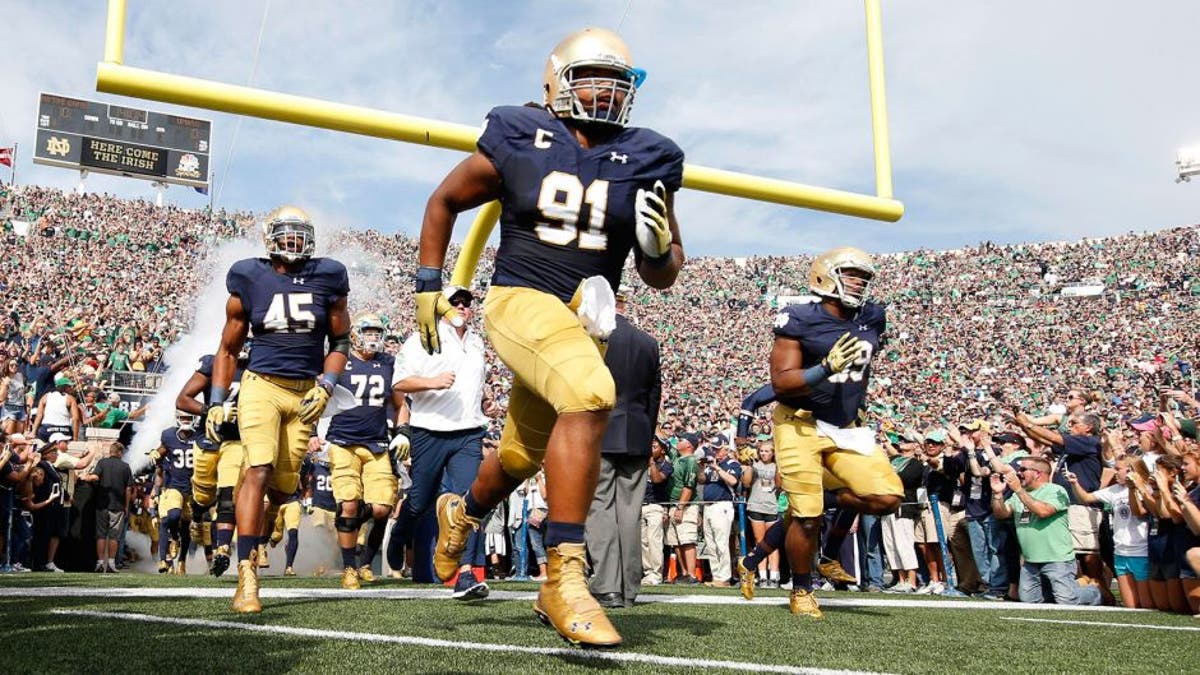
Sep 26, 2015; South Bend, IN, USA; Notre Dame Fighting Irish defensive lineman Sheldon Day (91) leads the team onto the field before the game against the Massachusetts Minutemen at Notre Dame Stadium. Mandatory Credit: Brian Spurlock-USA TODAY Sports
The College Football Playoff rankings are back, and with it, our weekly attempt to parse the meaning of every last word committee chairman Jeff Long says.
This week, Long made it fairly easy by introducing a new buzz phrase -- "wins against teams with better-than-.500 records." Both on television and in a media teleconference that followed, Long continually broke out that faux metric to explain why, for example, Clemson is No. 1 (four wins against plus-.500 teams, including No. 5 Notre Dame).
My interpretation: He's using that as a placeholder for now until we get more games between fellow contenders, at which point "Top 25 wins" will return as the criteria du jour. Because it's fairly ridiculous to suggest that Ohio State is No. 3 primarily due to beating "better-than-.500" foes NIU (5-3) and Western Michigan (5-3).
Now, a few key takeaways from Tuesday's first episode of "Selection Committee, Season 2."
Wow, is Notre Dame in good shape: Without question, the biggest surprise Tuesday night was seeing the 7-1 Irish all the way up at No. 5. (Some might say it's No. 4 Alabama, but c'mon … are you ever surprised when a group of voters lionizes Alabama?) The committee clearly values Notre Dame's recent schedule, in which it lost a close game at No. 1 Clemson, then beat 6-1 Navy, 5-3 USC (which is clearly better than its record) and 7-1 Temple. Even better, the Irish close with 7-1 Stanford, the committee's No. 11 team and potential Pac-12 champion.
The one obvious concern is that an undefeated Big 12 champ (TCU, Baylor or Oklahoma State) would eventually pass the Irish, as could No. 12 Utah if it runs the table and wins the Pac-12. I would not be as worried, though, about a one-loss TCU, Baylor or Oklahoma State because the Irish should still finish with a stronger schedule.
The Pac-12 … not so much. Don't freak out yet, Larry Scott, over the fact that not a single Pac-12 team made the committee's initial Top 10. After all, eventual national champion Ohio State debuted at No. 16. But it's certainly not encouraging that Stanford checked in lower with the committee than the AP poll (where the Cardinal are ninth). And both Stanford (against Notre Dame) and Utah (against UCLA) only have one game apiece remaining against current Top 25 teams.
Basically, the league has no margin for error. Either Stanford or Utah needs to run the table and finish as a 12-1 champion and hope both TCU and Baylor stumble.
It could have been worse for the Big 12. Not surprisingly given their light schedules to date, No. 6 Baylor and No. 8 TCU both began lower than they are in the AP poll (second and fifth, respectively). But given the committee's emphasis on schedule strength, it's debatable whether they even should have been that high. For example, No. 9 Iowa boasts three of the plus-.500 wins Long kept mentioning (6-2 Pittsburgh, 7-2 Wisconsin and 6-2 Northwestern), but when I asked him why the Horned Frogs and Bears, which have just one each (Texas Tech), he pinpointed their explosive offenses.
Translation: Eye test.
So you're saying Memphis has a chance? Last year's initial rankings included one Group of 5 team, East Carolina, at No. 23. Memphis debuts 10 spots higher thanks in large part to its win over Ole Miss and still has at least two games remaining against other committee-ranked teams, No. 22 Temple and No. 25 Houston.
"We just think they're a really solid team that has scheduled and won games against higher-ranked teams," said Long. "So that was impressive to us."
We know most of the teams above the Tigers will lose at least one game over the next five weeks, so a 13-0 Memphis team would have a pretty compelling playoff case. It's probably not going to beat out a one-loss Power 5 champ or Notre Dame but we're only a couple losses away from potentially two of those bowing out.
The season is fluid. No. 4 Alabama and No. 10 Florida have the same record, but one of them (Florida) beat Ole Miss handily, the other (Alabama) lost to the Rebels at home. So why, then, the discrepancy?
Long again cited quality wins -- three for Alabama (7-2 Wisconsin, 5-3 Georgia and 6-2 Texas A&M), two for Florida (7-2 Ole Miss and 5-3 Georgia). But he also made an interesting distinction. On Oct. 3, Alabama won 38-10 against a 4-0 Georgia team that still had star running back Nick Chubb and whose quarterback, Greyson Lambert, came in playing well. Four weeks later, Florida won 27-3 against a reeling Georgia team with no Chubb and a complete mess at quarterback.
"Definitely, all those things are part of the discussion," said Long.
I don't agree that Alabama is six spots better than Florida, but I do agree that opponents change from week to week and one advantage of a committee is it can take that into account.
One disadvantage: They have the flexibility to selectively apply certain criteria, and you saw that here. Some teams got the plus-.500 boost, others got by on the eye test. As teams continue building their resumes we will deserve more consistent explanations.
Stewart Mandel is a senior college sports columnist for FOXSports.com. He covered college football and basketball for 15 years at Sports Illustrated. You can follow him on Twitter @slmandel and Facebook. Send emails and Mailbag questions to Stewart.Mandel@fox.com.
